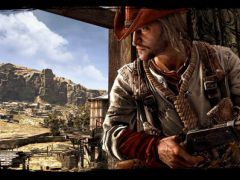Video Gamer is reader-supported. When you buy through links on our site, we may earn an affiliate commission. Prices subject to change. Learn more
After a woefully ill-advised trip into the present day with Call of Juarez: The Cartel (‘guys, guys – instead of the Old West, what about…the NEW WEST?’), I hadn’t held out much hope for Gunslinger. Sure, the older entries were OK, but two Dead Island games and a downloadable release later, this seemed little more than a cash-in. Something to knock out before the dev got back to the unenviable task of making its inevitable next-gen zombie-fest even buggier than before.
I’m happy to say I was wrong. Gunslinger’s not the greatest game ever made, and nor does it have to be. Instead it’s a fun – and at times surprising – little take on everyone’s dad’s favourite genre.
Gunslinger’s tale is told by Silas Greaves, a washed-up gunfighter drinking his way to the grave. He narrates his (your) actions as you go about them, taking players – and the disbelieveing drinkers of the saloon he’s chosen to tell his story in – through a potted history of western fables; famous faces, a lifetime of revenge and tales that couldn’t be more unbelievable if Kojima had written them.
Unsurprisingly, given Silas’ line of work, this means killing a lot of people. Gunfighter’s combat is pretty average – point and shoot, with an XP/combo system and related upgrade trees to prop it up. Your guns are perfectly serviceable – the fact that killed foes fall dramatically in slo-mo for a short while after death helps matters – but never really feel as powerful as they should.
Your enemies aren’t the smartest bunch either: a lot of them will simply stand still and return fire, waiting for you to make them one more statistic in the Big Book of FPS Deaths, 1992-2013. Others will make a run for cover, and generally are harder to take down. Not necessarily because they move quickly – arthritic tortoises have moved faster than these boys – but because your shootin’ irons can be frustratingly inaccurate. Some enemies have health bars, shields, or try and bum rush you, but these guys only serve to remind you how archaic some of it feels.
A slow-motion mechanic – fuelled by a basic combo meter – stops affairs from becoming totally forgettable. Kill with a certain style – headshots, picking off moving foes, blasting them at close range with your shotgun – and you’ll be awarded points. These multiply with each successive kill, filling up your Bullet Time gauge (as well as giving you points to spend on upgrades).
Activate it and you’re now a darn-tootin old-style Max Payne: Red Dead meets Lethal Enforcers II. Other elements pop up now and again (QTE shooting, end-of -level duels, dodging bullets in slow motion as they career towards your head) but again: it’s all very simple. Comforting, even, in a shoot-everyone-dead-and-that’s it kind of way, but not very involved.
While the shooting might be serviceable (and, in fairness more enjoyable as you unlock more perks, of which you choose from 3 trees) it’s the world and story that’ll keep you interested. The decision to go for a cel shaded look serves to hide most of the game’s graphical blemishes (this is still Techland, remember), and actually goes some way to crafting an enjoyable atmosphere for the world. Granted, the environments aren’t the most original I’ve ever seen, but Techland knows this, and knows how to leverage them.
Silas, mad old drunk that he is, is as unreliable a narrator as they come, and the game plays around with this to surprisingly well-realised comic effect. Multiple times your mission will begin again after one of the drinkers calls bull**** on the story, and there’s a nice repartee between the guys at the table. It’s laden with more western clichés than an entire Clint Eastwood boxset being narrated by Sam Elliot – dressed as a horse – but Techland has used them to its advantage, enabling the developer to play around with level and enemy design.
What’s that? The world is building right in front of you? Hazy recollections coming into focus, of course. Fighting ghostly enemies? A drunk old man telling tall tales. At one point Silas leaves the table to go to the toilet, and the other characters discuss the probability that his story is a crock of s***. In game, nothing happens bar a stumble through a train car – no gunplay, no enemies – until he returns, at which point the story – and the shooting – shooting resumes. It’s touches like these that kept me playing, and although the game may be predictable, it never outstays it’s 5 or so hour running time.
Once you’re done reliving the past, you can either start again in New Game + (keeping all of your weapons and skills) or jump into one of the other two score attack modes. Arcade tasks you with comboing as many enemies together against a par finishing time (think Resident Evil’s The Mercenaries, but in reverse). It’s a welcome distraction, and one that proves while the combat might be basic, there’s still a lot of fun in shooting fish in a barrel. You’ll also get to engage in a series of duels. Speaking of which: no-one seems to have quite figured out how to do these correctly, but Gunslinger’s combo of using the sticks to position the draw hand and focus your target – as well as waiting for the right time to shoot – is pretty good. Much like the game as a whole then.
Version Tested: Xbox 360
